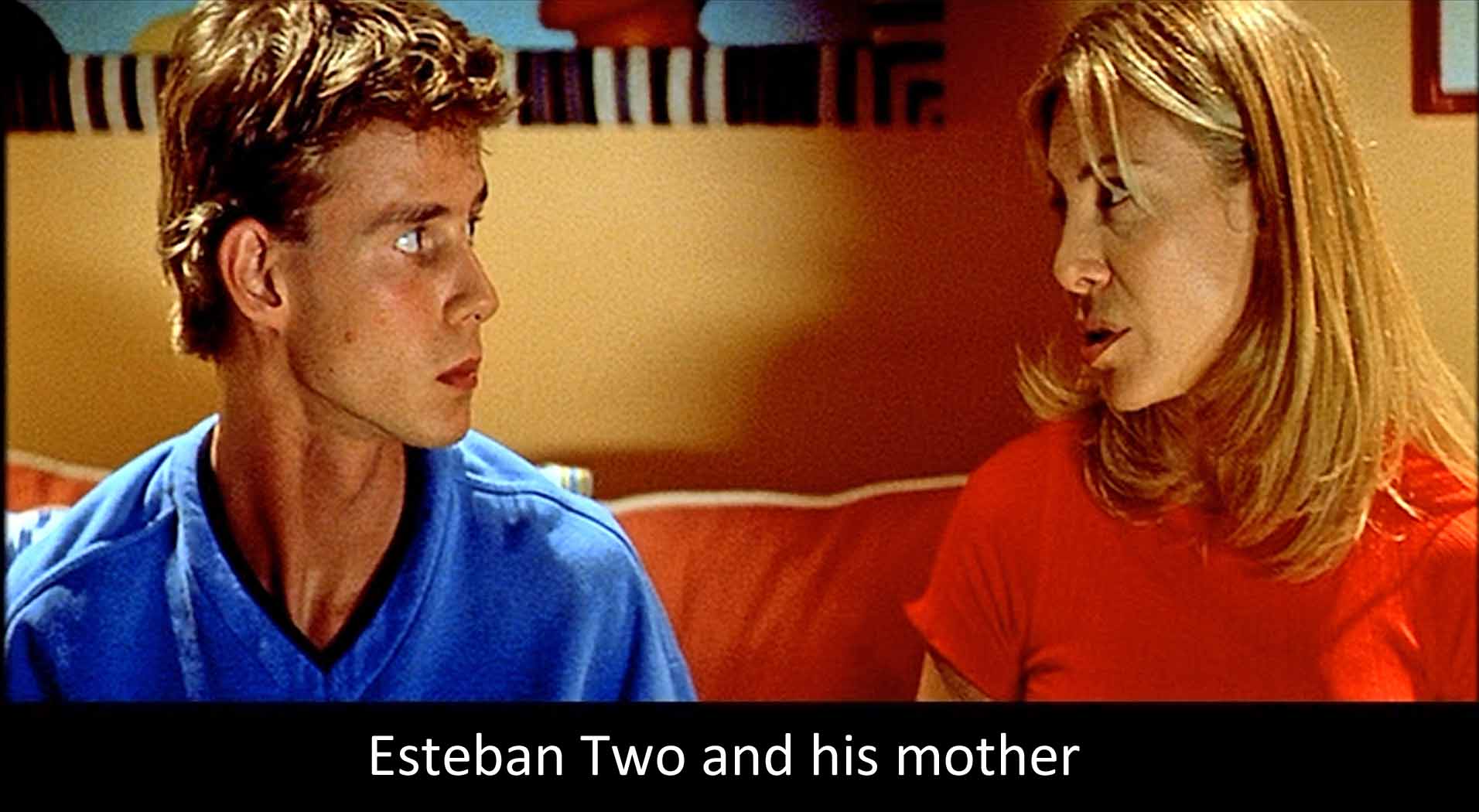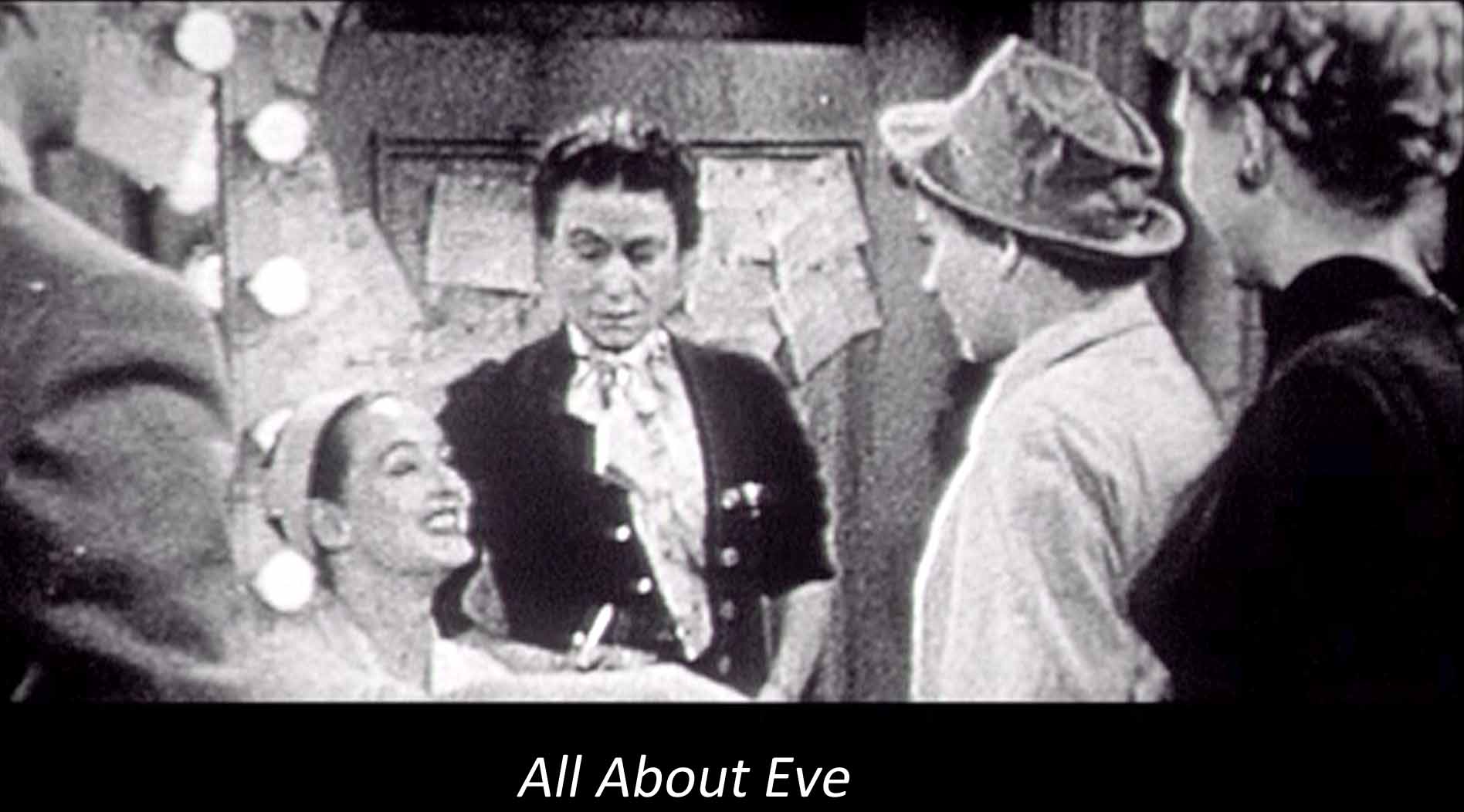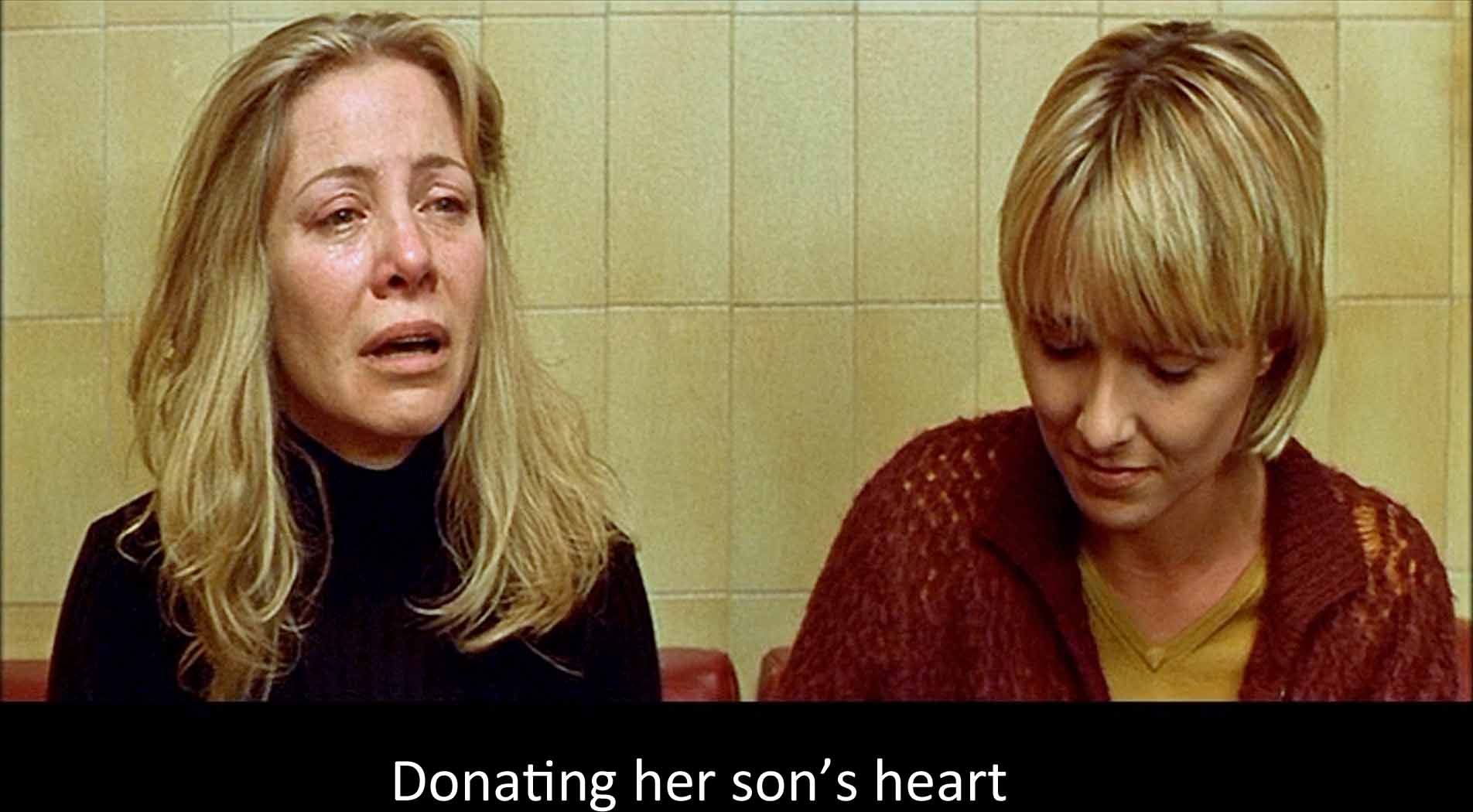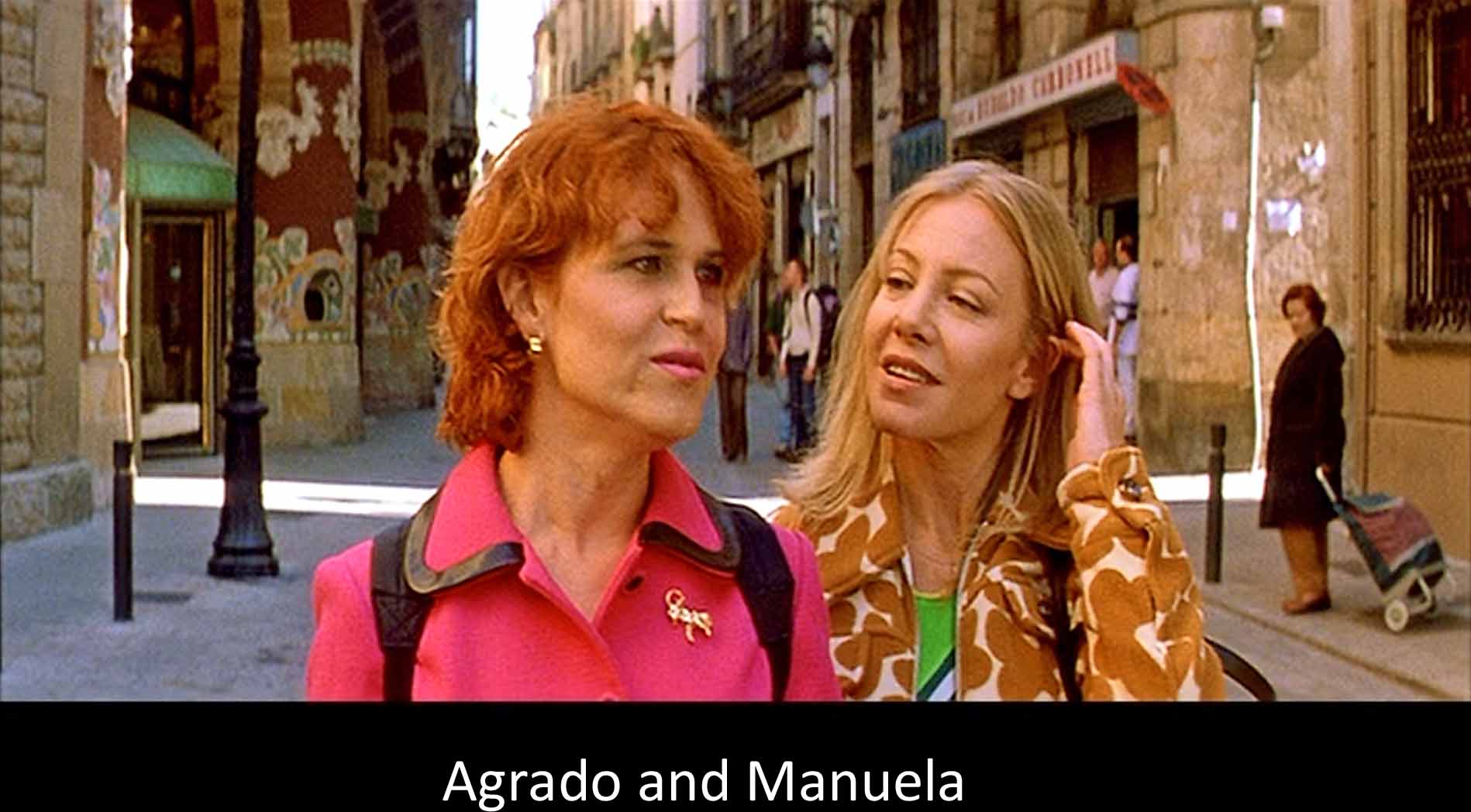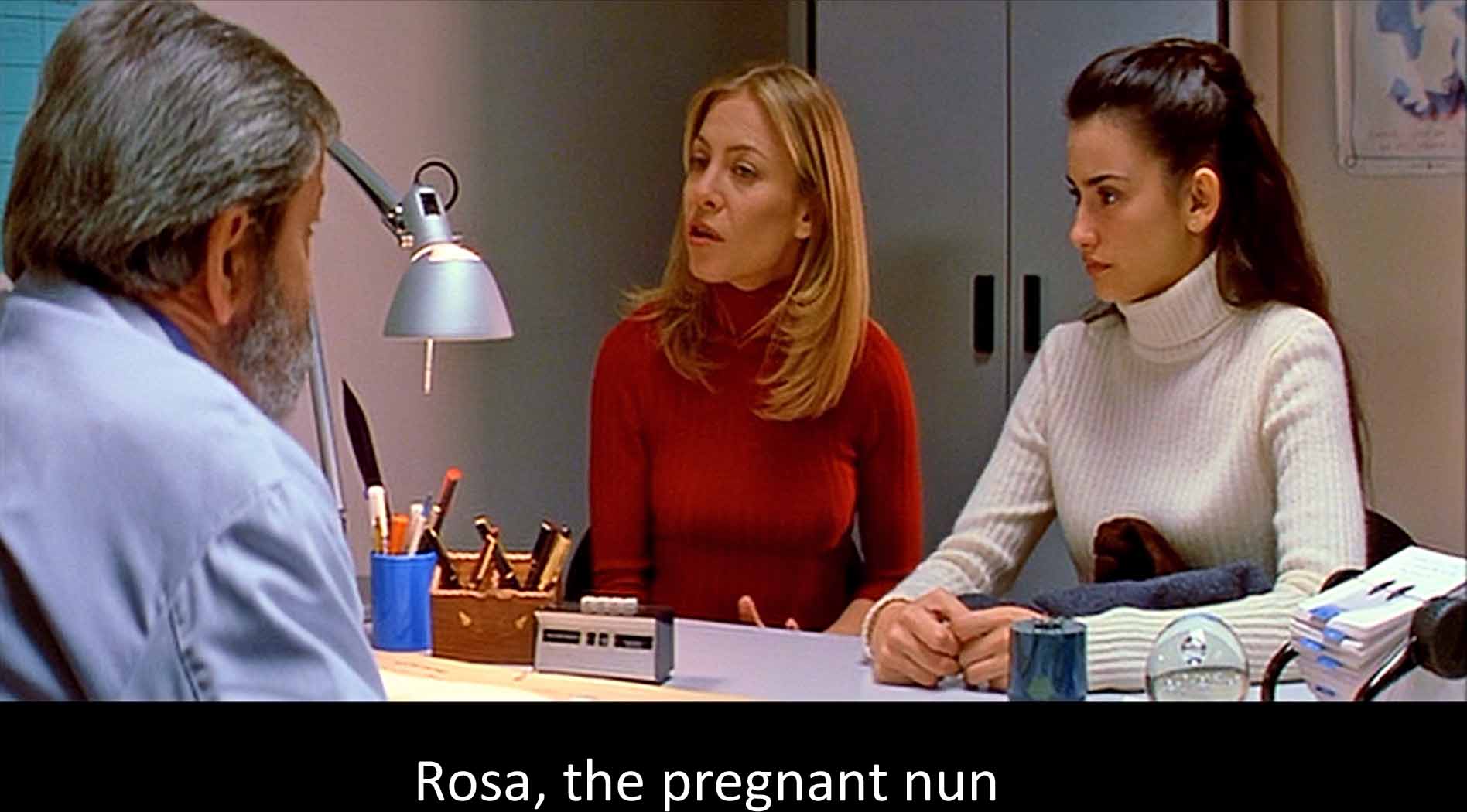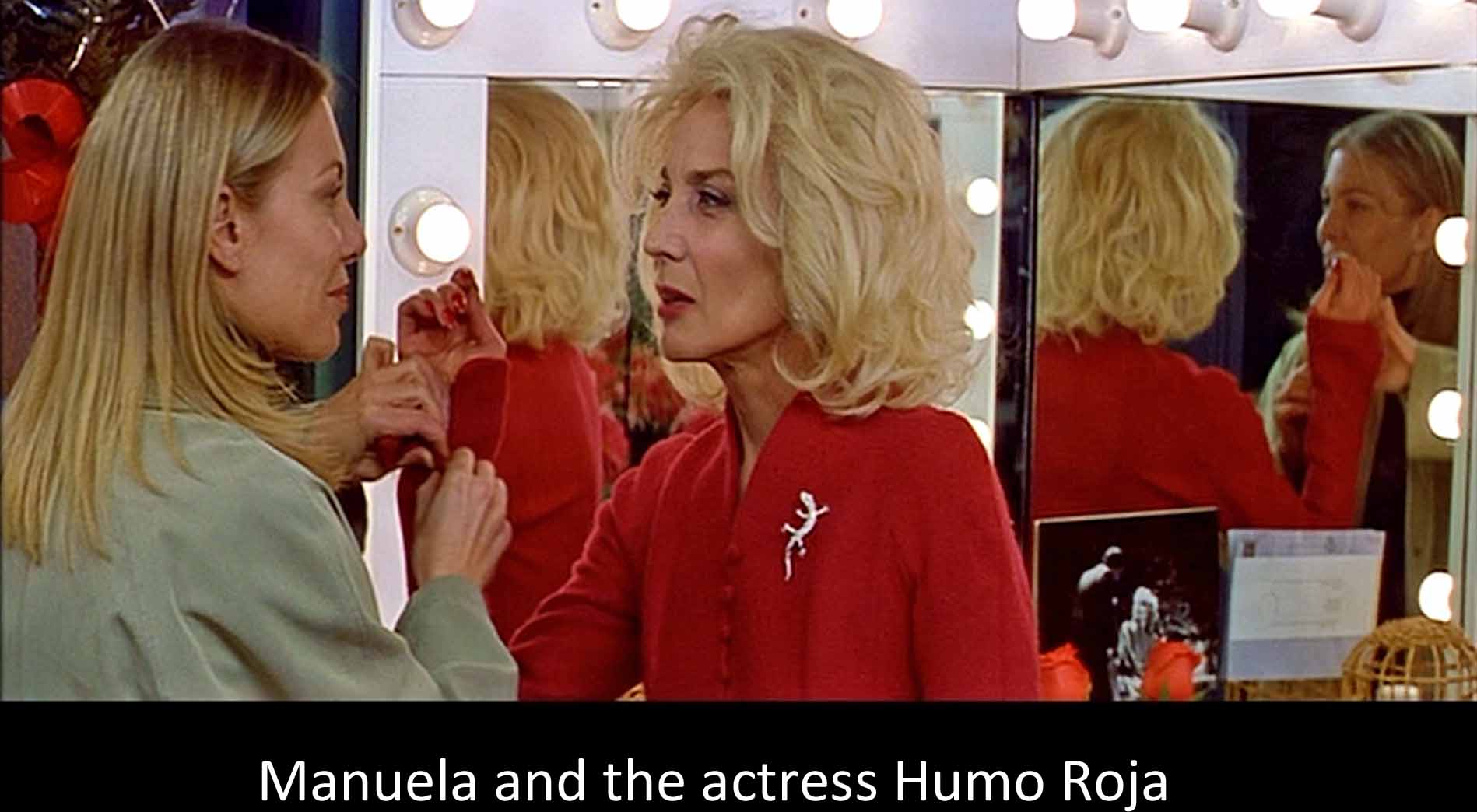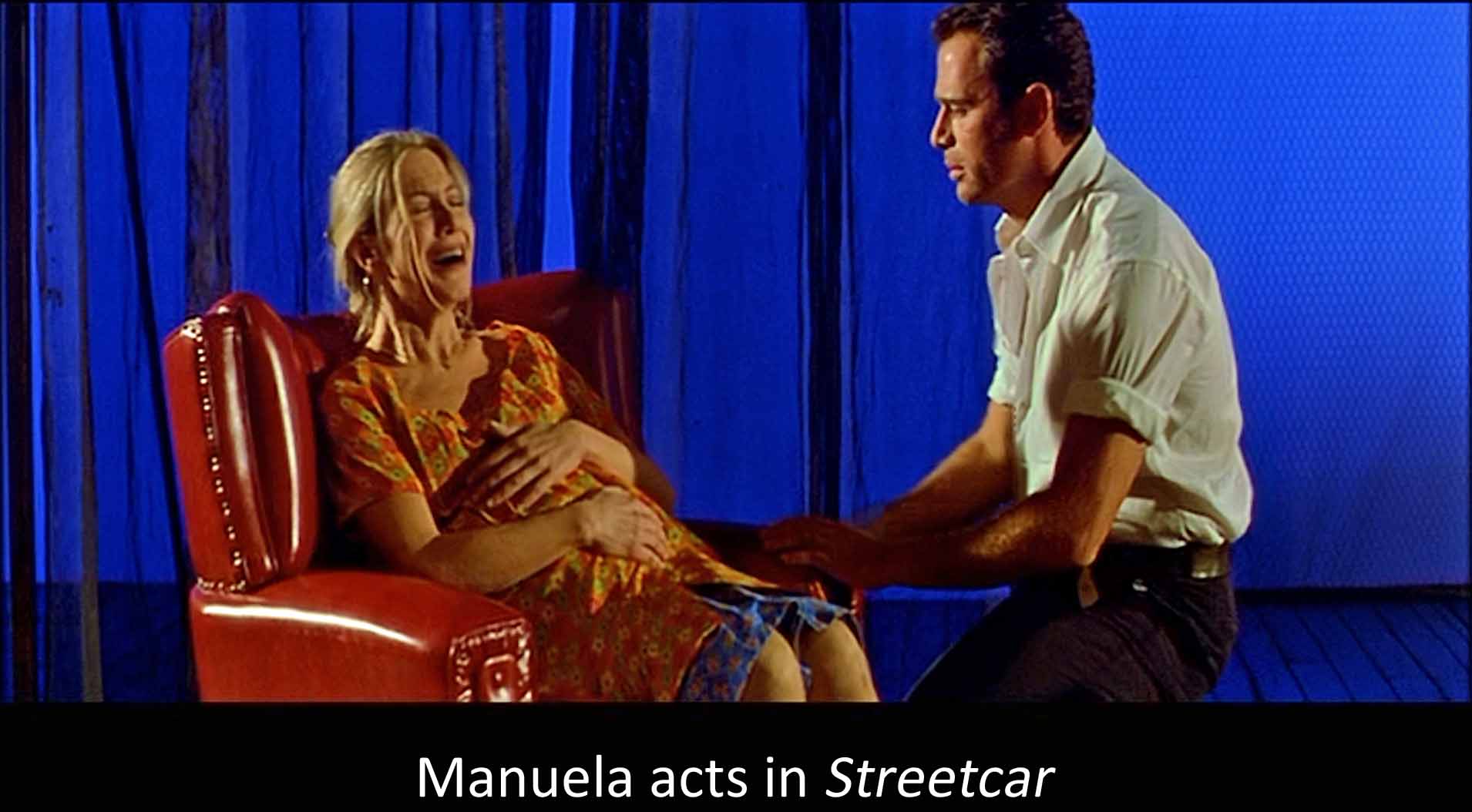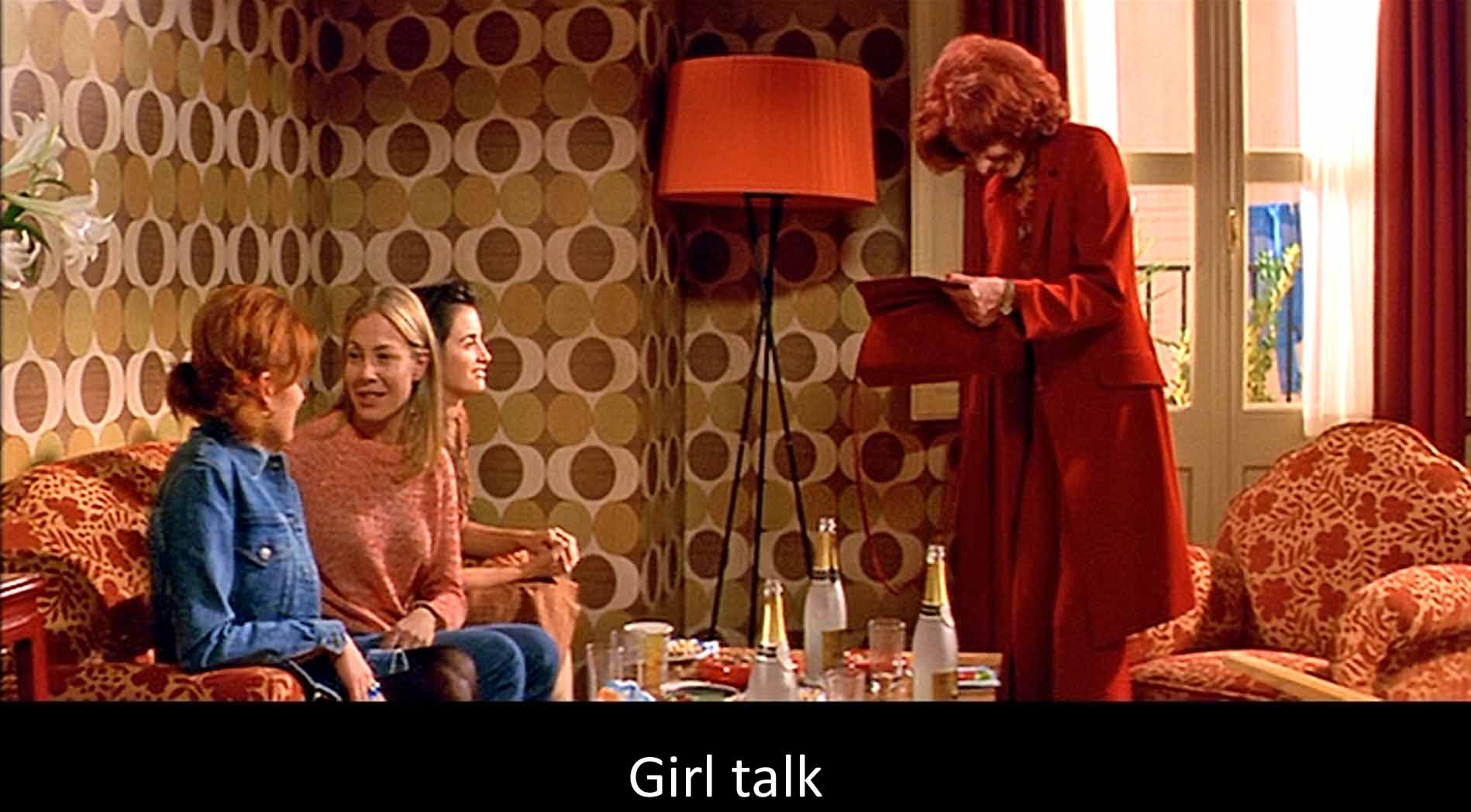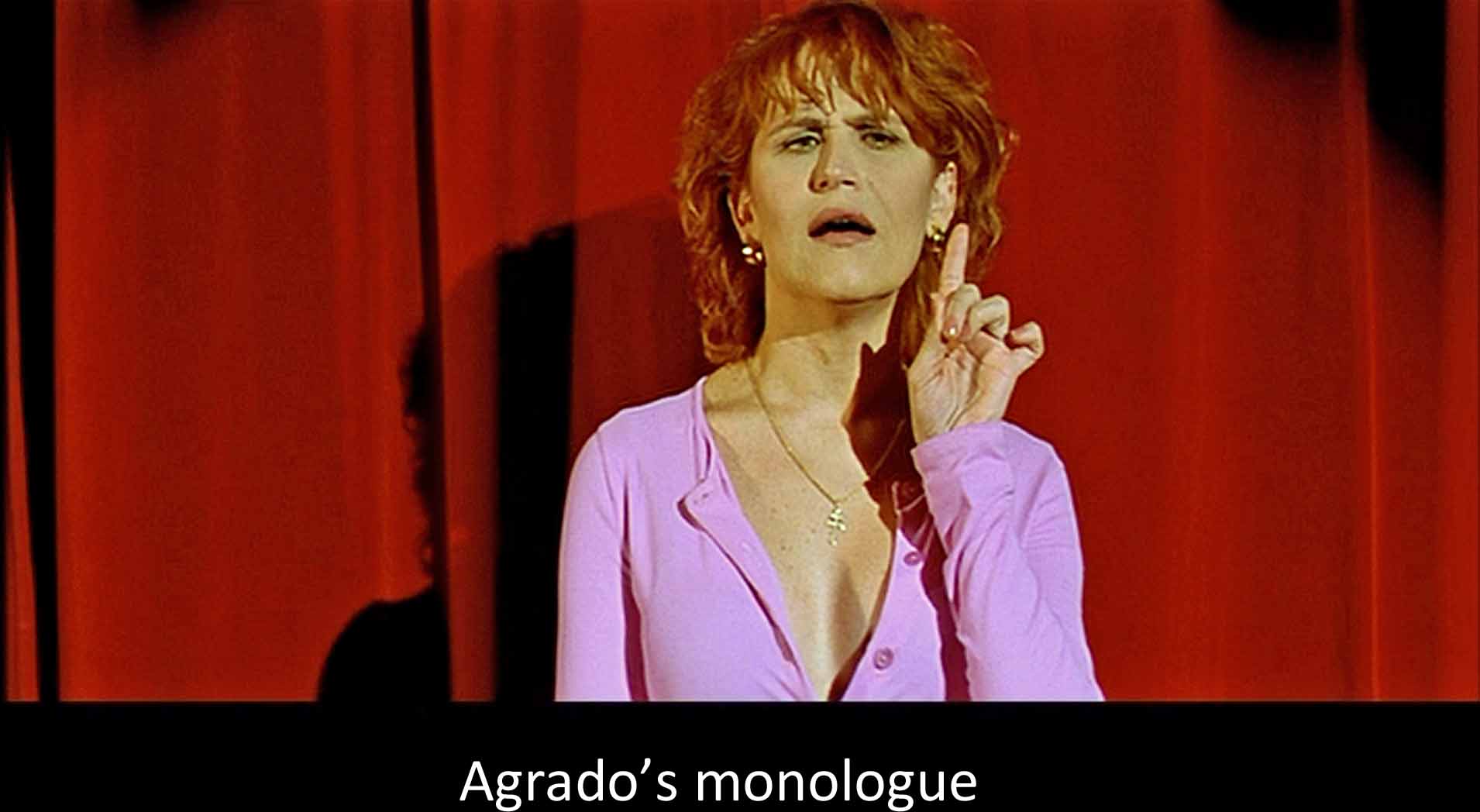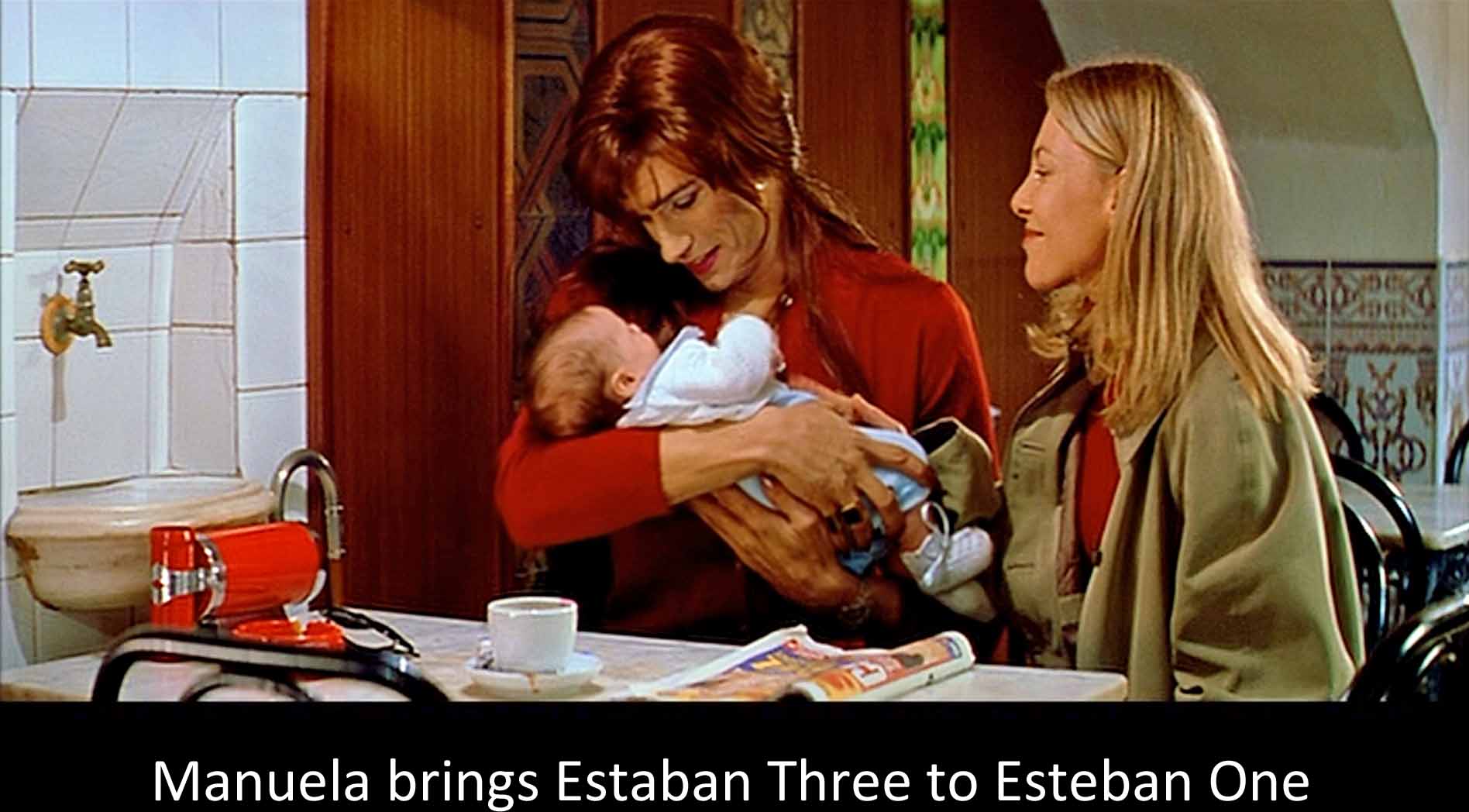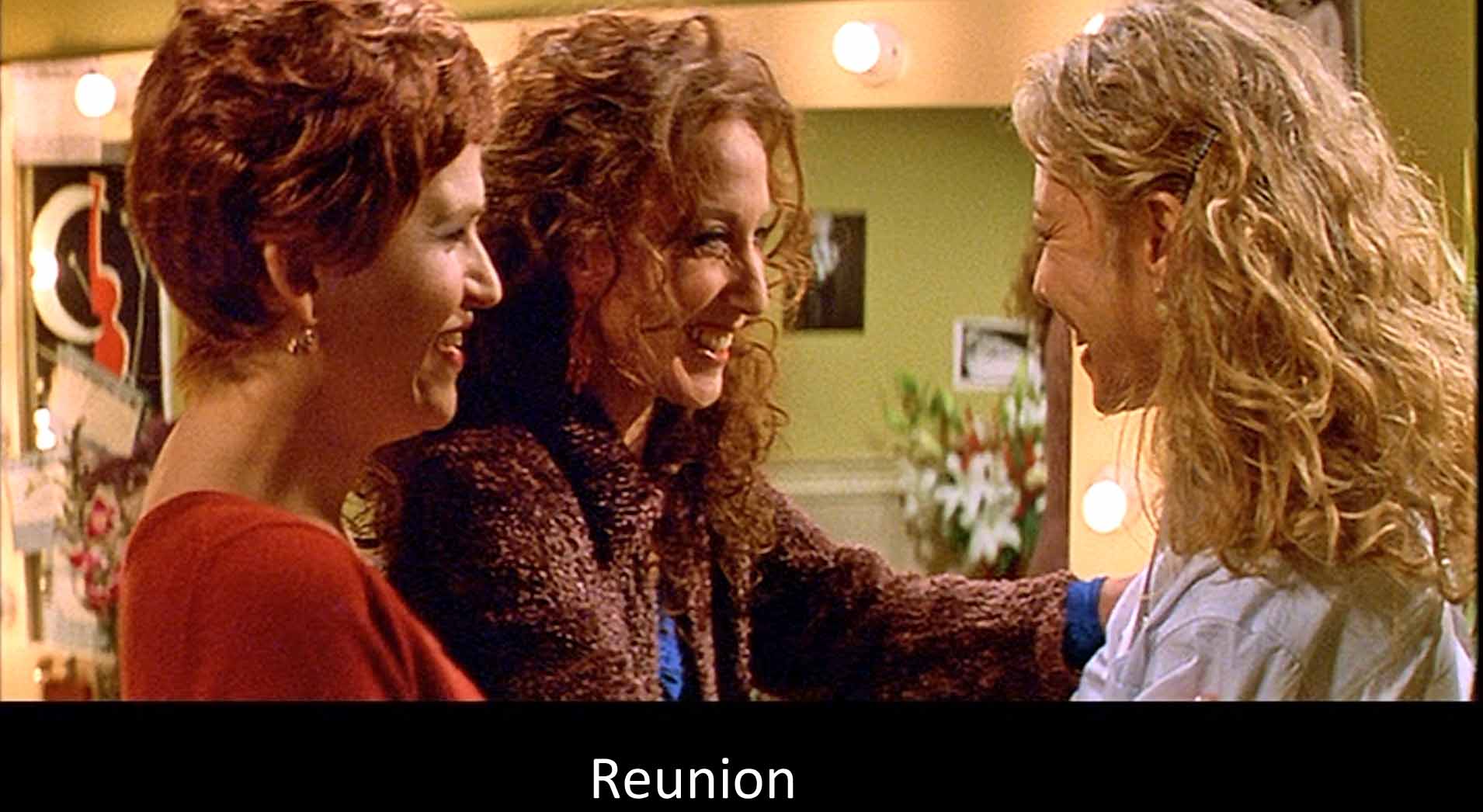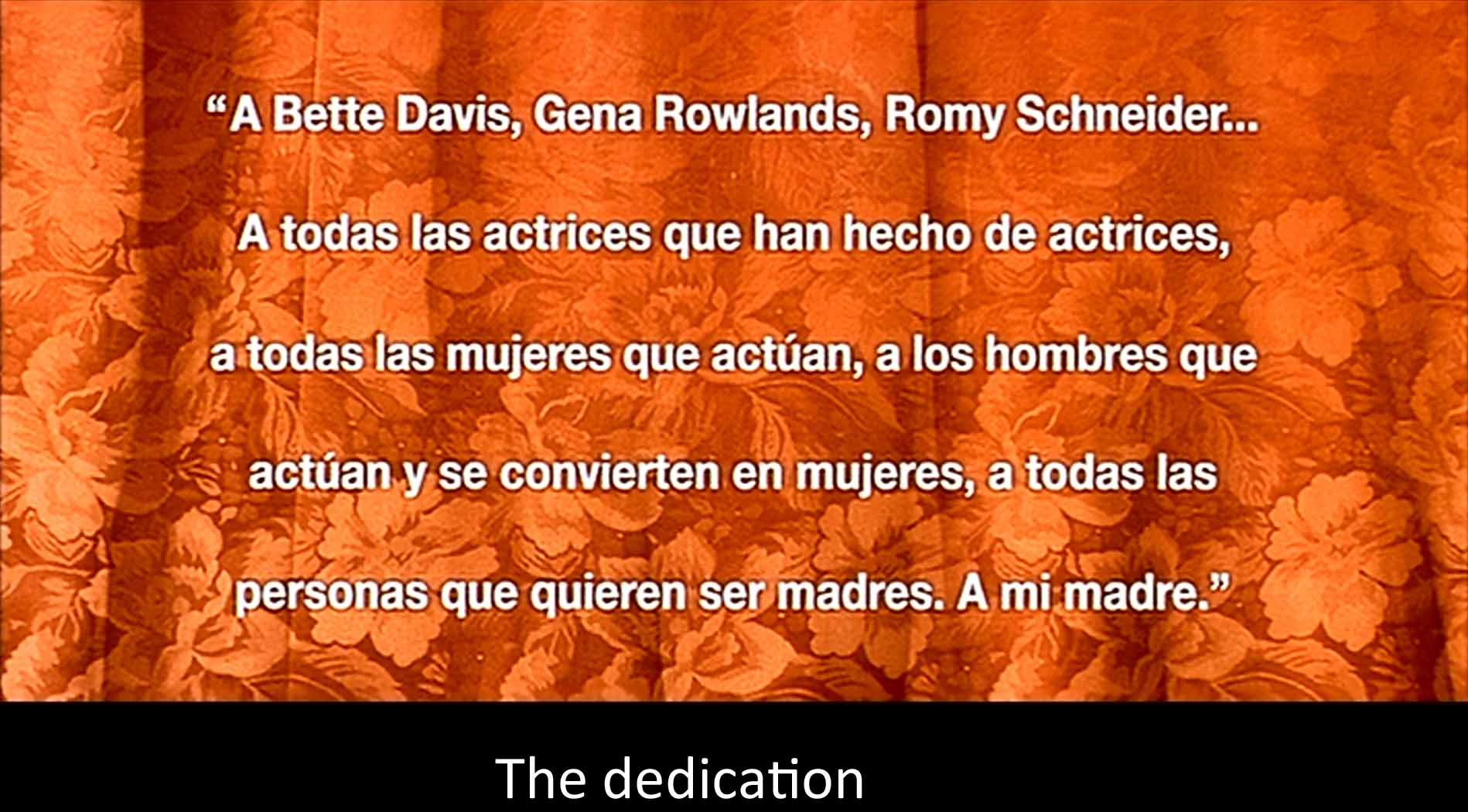This is a film about identity. Identity, from Latin idem, the same. But not with Almodóvar. Anything but.
Think of all the things by which you establish what you think is your identity: your name, your body, your gender, your nationality, your parentage, your style of speech, the way you walk and talk, the clothes and look you have. Almodóvar undoes every one.
Name. The transgendered characters change their names: Agrado (Antonia San Juan) and Lola, formerly Esteban (Toni Cantó). Then there are the confusions of several Estebans. “Esteban” refers to Manuela’s and Lola’s son (Eloy Azorin) who dies early in the film, hit by a car. He is Esteban Two, the middle generation. But “Esteban” also names Rosa and Lola’s child (Esteban Three), and it names “Lola” before her sex change (Esteban One). Esteban One is the father of Estebans Two and Three. There are also two Rosas, the young nun played by the 22-year-old Penélope Cruz, and her cranky mother (Rosa Maria Sardá), a painter of fake masterpieces.
The star actress (played by Marisa Paredes) is identified by a huge poster that, however, dissolves into the dots of halftone. She coined a name for herself, Huma Rojo, which approximates “red smoke.” She took the name from her incessant cigarette smoking (but it is not her own smoking—she is imitating Bette Davis). She thereby identifies herself as something fleeting, evanescent—that’s identity in this movie. And, of course, the quest for an autograph—a name—proves fatal for poor Esteban Two.
Body. You would think your body is the most personal and immutable thing about yourself, but not in this film. It opens with a death in a hospital—and death surely obliterates identity. Or does it? The organs live on in others’ bodies—Esteban’s heart, for example. Does that change the identity of the organ’s recipient? Maybe. And then there are all those transvestites with various body changes. Rosa’s father, stricken with Alzheimer’s, asks everyone their age and height, as if they were what identified them. But they are meaningless. Almodóvar’s point is that our bodily identity in an age of transplants and surgery is fluid, hardly unchanging.
Nationality. Although the film is set in Madrid in the center of Spain, the characters talk of going to El Salvador or Argentina. Within Spain, Manuela goes here and there, first to A Coruña in Galicia, then to Barcelona in the doubly named Catalunia or Catalonia. These are both regions that resist their supposedly Spanish identity. So, are they Spanish or something else? What is Manuela’s nationality, Lola’s, Huma Rojo’s? We can’t be sure. When Rosa is about to give birth, Manuela happily says, “They put Videla in jail, and your son is going to be born.” Dictator Jorge Videla had presided over the stealing of babies from “enemies of the state” in Argentina, and that is where this baby’s father, Lola, is headed. When Manuela returns to Barcelona, the song that accompanies her is Ismaël Lô’s song Tajabone. He is the “Bob Dylan of Senegal,” and this is more of the film’s globalizing fluidity.
Sex. The simplest M or F you put on a form in the U.S. becomes in this film startlingly indeterminate. All About My Mother is all about women caught between the demands of the body and the role-playing required of women in general and mothers in particular. (Almodóvar is famously a “woman’s director” [cp. Cukor, Hawks], and this film came out shortly after the death of his mother to whom he was particularly devoted.)
Homosexuality was a no-no for a long time in Spanish cinema, and Almodóvar flaunts unconventional sexualities in his films to challenge traditional, repressive values. Here, Huma and Nina (Blanche and Stella in Streetcar) have a lesbian relationship. Notice how many of the writers referred to in this film are gay: Tennessee Williams, Truman Capote, Garcia Lorca or writers who featured homosexuality like Boris Vian. Esteban Two kids his mother by suggesting he might become a male prostitute.
The partially transgendered characters, Agrado and Lola/Esteban One create all kinds of sexual relationships. Are these characters men or women, “he” or “she”? Ostensibly shes, they nevertheless have penises and Lola, at least, fathers children. What is a real father, a real mother?
Parents. The title is Todo Sobre Mi Madre, but who is the “Mi”? Who is the “I” telling us all about his or her mother? The title apparently refers to the baby, Esteban Three, and his mother would be Manuela (Cecilia Roth), but she isn't his mother, Rosa is. (Or is the transvestite Lola, now a “she,” his mother? Or his father? Rosa herself puts her own mother aside and adopts Manuela. Her father cannot recognize her, although her dog can (shades of Homer's Odyssey). Parenthood is as fluid in this film as everything else.
The opening shot is of an intravenous “drip”, and it accompanies credits whose lettering flows and melts. Soon after, we see a comical diaper ad that promises that not a drop of urine will escape. Then there is rain and later drinks and ice cream as the three ladies entertain one another with their thoughts on sucking cocks.
More fluidity: Almodóvar rewrites the ending of A Streetcar Named Desire. In the original, the play ends when Stella submits to Stanley's overwhelming macho sexuality. In the version in All About My Mother, Stella takes their baby and abandons Stanley. It's all part of the fluidity of Almodóvar's world.
In the same way, Almodóvar likes to use locations where people change themselves. In this film and in his others, he likes to use dressing rooms and bathrooms whose mirrors allow for visual play with identity as people change themselves. In this film, people use trains, taxis, cars, and theaters. When Manuela goes to and returns from Barcelona, she passes through a long tunnel. Almodóvar himself calls it “the tunnel of memory" (194), but you could read it as an image of birth or rebirth.
In short, none of the traditional markers for the identity of humans or art works in this movie. What Almodóvar offers instead is performance (or, to use current critical jargon, performativity). You are the way you perform yourself. Or, in a quote from Agrado's onstage presentation of self that one could call the philosophical core of this film, “You are more authentic the more you resemble what you've dreamed of being." The partially transgendered Agrado is talking about herself, and she uses feminine pronouns. You could translate her line as, “The more a woman resembles what she has dreamed for herself, the more genuine she is." But, of course, she is neither woman (completely) nor genuine.
Almodóvar ends the film by ringing down a theatrical curtain and showing against it a dedication stating its link to performance: “To Bette Davis, Gena Rowlands, Romy Schneider . . . To all actresses who have played actresses. To all women who act. To men who act and become women. To all the people who want to be mothers. To my mother."
All About My Mother abounds in performances of one kind or another. The first we see is Manuela acting in the “seminar" to encourage organ donation. But then there's a turnaround: she can't just pretend; she really has to authorize the donation of her son's heart. Manuela defines herself as a mother. She performs motherhood as much as she is a mother in fact. Her showing the baby to its father, Esteban One, is a performance, as is her showing him the photograph of his son, Esteban Two.
We see three different characters perform the role of Stella in Streetcar Named Desire. Blanche in that play prostituted herself, as do Lola and Agrado in this film.
In this film, transvestites are constantly presenting themselves, as are the prostitutes in Barcelona surrounded by circling cars from which customers shop for sex, a street theater in which the audience moves but the actors don't, as Robert Hughes points out. (This area, dedicated to prostitutes, he notes, is known as the via liturgica.) The whole film is a performance based as it is on All About Eve, with both Manuela and Agrado as the fan insinuating herself into, first, the dressing room, then the star's life, then the performance. But performance with a difference. The film acts out the opposite of All About Eve: Manuela and Agrado help Huma; they don't replace her.
We could think of such moves as echoes or rhymes, repetitions with variation. There are three different versions of organ transplantation. There are three different Estebans. Manuela leaves Barcelona pregnant with Estaban Two and leaves Barcelona again with Esteban Three.
Three different women act the part of Stella in Streetcar. In the play, Blanche searches for her “heart" (a jewel case) as Manuela had searched for the heart of her son Esteban Two.
There is a clip from All About Eve near the beginning, Bette Davis complaining about autograph hounds. The echo comes when Esteban Two dies trying to get Huma's autograph (an echo of Cassavetes' Opening Night). And near the end of the film she supplies that autograph. Another echo comes late in the film with a still photo of Bette Davis smoking, the source of Huma's name. And then there are Huma's various wigs.
There are complicated repetitions around photographs, those with Esteban Two's father torn off, his wanting to find his father (shades of the Odyssey), his father (Esteban Three) finding him as the photograph Manuela gives him. That photograph passes from Manuela to Esteban One to Huma who has no real connection with the boy, but it is with her that the photo will remain.
Outside the theater, there is a huge poster of Huma Rojo, a photograph that dissolves into its halftone dots. They, in turn, occur again in a black-and-white painting in Manuela's apartment.
Manuela fixes her son a meal and a salad for Agrado. Later, Huma announces she just wants a salad. Early in the film, Manuela gives her son, the would-be writer, Truman Capote's Music for Chameleons. Late in the film, Huma shows up with a chameleon pin on her red dress. And what animal challenges identity more than a chameleon?
Chief among these echoes are the many meetings, partings, and reunions. The film is a long series of these comings together and going apart. I hesitate to suggest this reading but I feel bolstered by Almodóvar's interest in all his films in the biological aspects of gender and sex. These comings together and goings apart act out the joining and parting of the sexual act itself. It is as though Almodó perhaps unconsciously, built this film, so much about sex and gender, around his own inner preoccupation. Indeed, the scene where Manuela rescues Agrado from a man who is assaulting her is a classic “primal scene.” And isn’t this film all about creating a family from unlikely parents and children?
A final promise of reunion and repetition comes in the last words of the film: Huma says, “See you later," as she exits to repeat her acting. The film has dozens of these little echoes that suggest the script behind the action. These people are performing although they don't know it. Or they aren't. The film foregrounds two scripts: All About Eve and A Streetcar Named Desire. But the film contradicts the two scripts. Manuela does not usurp Huma Roja's career as Eve Harrington does in All About Eve. And the Streetcar we see here has a pregnancy and motherhood not in the original. The point is, We are not scripted.

